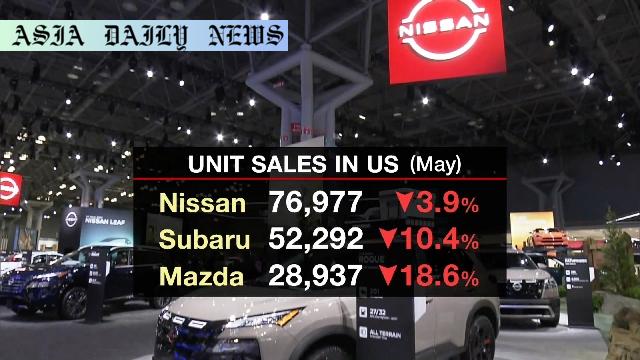Japanese automakers report varied May sales, with Toyota, Honda, and Mitsubishi showing gains, while Nissan, Mazda, and Subaru see declines.
Japanese automakers announced mixed US sales results for May.
Toyota, Honda, and Mitsubishi reported sales growth.
Nissan, Mazda, and Subaru experienced declines due to inventory issues.
Automakers are preparing to raise prices amidst inflation concerns.

Overview of May Sales Performance
The US automobile market showed a varied trend in May for six major Japanese automakers, reflecting the changing dynamics of the industry. While some companies celebrated increased demand and growth, others faced significant challenges, such as inventory shortages and reduced consumer enthusiasm as the rush to dodge additional tariffs eased. These results provide a snapshot of broader economic pressures and consumer trends in the automobile industry.
Winners Among Japanese Automakers
Toyota emerged as the top performer, recording a remarkable 10.9% increase in sales compared to the previous year, selling a total of 240,176 units. This achievement underscores the brand’s ability to maintain competitiveness and attract customers amid challenging market conditions. Similarly, Honda saw a healthy rise in demand, with sales climbing 6.5% to 135,432 units. Notably, Mitsubishi led the pack in terms of percentage increase, with a robust 13.7% boost to 9,194 vehicles sold. Analysts attribute these successes to the availability of competitive hybrid vehicles, which align with shifting consumer preferences for environmentally-friendly options.
Challenges for Other Automakers
Meanwhile, Nissan, Mazda, and Subaru faced declines. Nissan reported a 3.9% drop in sales, delivering 76,977 vehicles. Subaru struggled more significantly, with a 10.4% decrease in sales, selling 52,292 units. Mazda saw the steepest decline among the automakers, with sales dropping 18.6%, amounting to just 28,937 vehicles sold. Industry experts suggest that inventory shortages and reductions in sales incentives contributed to these declines, highlighting the importance of a balanced supply chain and aggressive marketing strategies in sustaining sales performance.
Broader Concerns and Future Outlook
The mixed sales performance aligns with broader market challenges, including inflation concerns and the looming impact of additional tariffs. Although Japanese automakers confirmed that price increases are on the horizon, they clarified that these adjustments are not directly linked to new tariffs but rather to broader economic pressures. As inflation continues to impact consumer purchasing power, automakers must carefully navigate pricing strategies to maintain competitiveness while managing costs effectively.
Conclusion: A Sector in Transition
Japanese automakers’ mixed performance in May reflects a sector in transition. While brands offering fuel-efficient and hybrid models gained traction, challenges such as inventory shortages and changing consumer sentiment affected others. As the industry continues to evolve amidst economic uncertainties, manufacturers must strengthen their adaptability, enhance product offerings, and focus on innovation to secure long-term success in the US market. Investors and analysts alike will closely watch automakers’ strategic responses in the months ahead.



Commentary
The Significance of May’s Sales Data
May’s mixed sales figures for Japanese automakers in the United States highlight the complexities of operating in a dynamic, highly competitive market. It is fascinating to see how different companies, despite shared challenges like inflation and tariff concerns, have diverged in their outcomes. Toyota’s stellar performance, for instance, showcases the effectiveness of robust product strategies and adaptability. Their commitment to fuel-efficient hybrids seems to resonate strongly with the environmentally-conscious US market, giving them a distinct edge over competitors.
Challenges Faced by Other Brands
On the flip side, the struggles of brands like Mazda and Subaru raise thought-provoking questions about inventory planning and consumer engagement. Reduced sales incentives appear to have played a role in these brands’ underwhelming performance. This underlines the importance of understanding shifting consumer priorities and effectively managing stock levels, especially in an economy where inflation may be constraining disposable incomes.
Lessons for the Future
Looking ahead, Japanese automakers will need to prepare for a market that demands innovation, quality, and value. The success stories of May suggest that investing in hybrids and other alternative fuel vehicles is a promising direction, particularly as governments and consumers alike push for greener technologies. On the other hand, addressing inventory issues swiftly should be a priority for companies facing declining sales. Balancing supply, demand, and pricing will be crucial as manufacturers navigate both immediate challenges and long-term industry trends. The automotive sector may face rough roads ahead, but adaptability and innovation will undoubtedly empower companies to steer effectively through them.